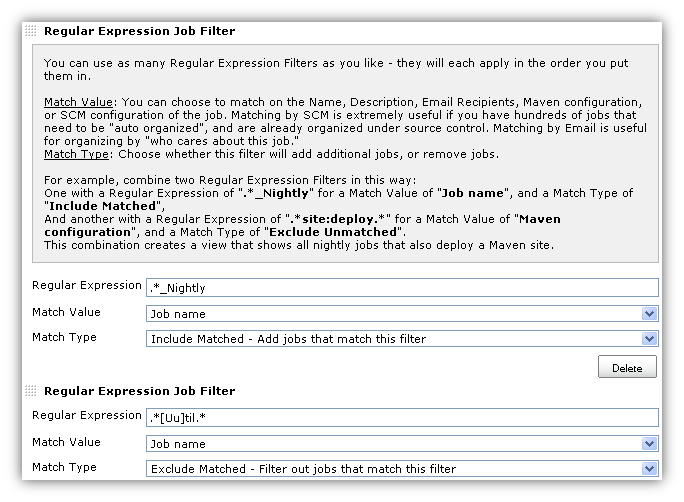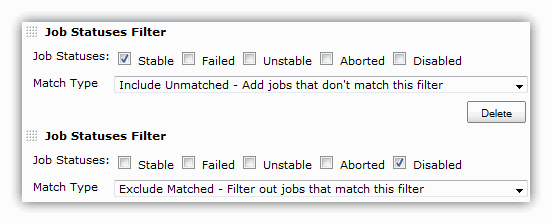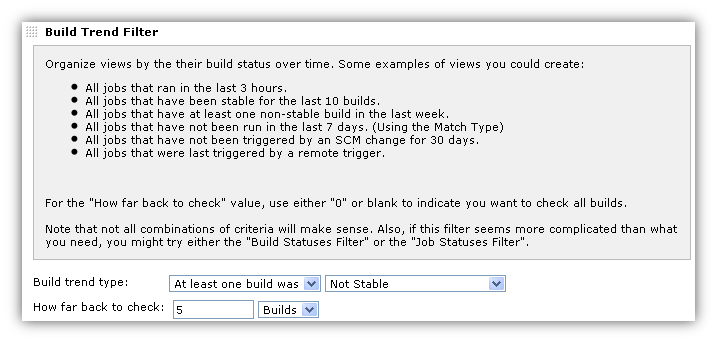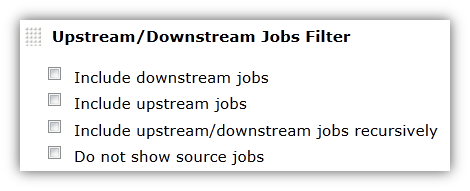Manage multiple views and hundreds of jobs much more easily. This plug-in provides more ways to include/exclude jobs from a view, including filtering by SCM path, and by any job or build status type, as well as "chaining" of filters and negating filters.
Create smart views with exactly the jobs you want. Your smart views can automatically include or exclude jobs by using things like the SCM path or type, the job type, build statuses or trends or triggers, relevance to the logged-in user, email recipients, Maven configuration, job parameterization, and user permissions. Mix and match filters to narrow down to exactly what you want.
This plugin provides a number of filters that you can "chain" together to provide a much easier way to create views to organize hundreds of jobs. For each filter type, you can add multiple filters, and combine them with filters of other types. For example, you can create a view of all your nightly jobs except those not under any SCM. In a nutshell, this plugin provides the following:
- Create view to manage hundreds of jobs by mixing-and-matching filters to include exactly the jobs you want
- Use regular expressions
to match against your choice of
- Job name or description
- Job's SCM Configuration path
- Email recipients for build
- Maven configuration for the job
- Chron Trigger
- Filter Parameterized Jobs by their configured parameters
- Create views relevant to the logged in user
- Also filter by
- SCM Type
- Job Type
- Job or Build Status or Status trends and triggers over a duration
- Jobs in another View
- User permissions for Jobs
- Upstream/Downstream jobs
- Filter out all but the most recent jobs
- Use the Build Filter (Wrapper) Column to render your favorite columns with the relevant builds.
Also, see this Cloud Bees write-up of the View Job Filters plugin.
- Install the plugin
- If needed, create a new view (besides the All view) by clicking the
"+" tab
- You might optionally want to see Editing or Replacing the All View - the default "All" view is not editable
- If editing an existing view, click the "Edit View" link (won't be available for the "All" view)
- You will see the following button in the "Job Filters" section.
Click it to select and add the filter type(s) you want.
With a large organization and hundreds of jobs, it will become very annoying and time-consuming to try to keep your views organized. The regular expression job filter can help, and there are multiple options to choose from to make it easier.
- Include/Exclude options - ability to either add jobs or filter out jobs based on the expression, or the negation of the expression
- Job name - allows you to filter out jobs when you have naming conventions. Also allows you to "narrow down" other filters, or to match the negation of an expression
- Job description - if you use descriptions, this may help you get what you want
- SCM Configuration - this one is perhaps the best bang for the buck - put in something like "./my-office-name/." to automatically include all jobs that are organized under source control already by office.
- Maven Configuration - looks at all your Maven goals, including freestyle projects, matrix (multi-configuration) projects, Maven projects, and Maven extra steps.
- Email Recipients - a great way to organize views by "who cares about this job". Will look in either the standard email publisher or the extended email publisher
- Job Schedule - searches the chron spec and description to group jobs by when they run - for example "weekend jobs"
- Node/Slave Label - matches against the Label Expression under the "Restrict where this project can be run" option
Create views that are most relevant to the logged-in user.
The "Name Matching" checkbox items are to allow you to get the name matching just right. The problem is that organizations often have different naming conventions that may not be consistent across version control, network logins, and email addresses. All of the options are checked by default so that this filter can make a thorough effort to find matching users.
The "Relevance Matching" options should be self explanatory. The point is to try and find all jobs that the logged in user cares about, based on their activity.
For the "How far back to check" value, use either "0" or blank to indicate you want to check all builds.
Note that not all combinations of criteria will make sense. Also take a look at the User permissions for Jobs filter.
This filter provides a number of options, and you can also add multiple of these filters, and choose different Match Types to include/exclude exactly the jobs you want. For example, you could create "Failed Jobs Only" and "Unstable Jobs Only" views, or make a more complicated view like the following example combination.
This filter gets a little more specific, and provides options to filter by the status of the job's builds. This example filters out (excludes) all jobs that have never built.
This filter is similar to the build status filter, but it takes into account the time in which the status changed.
The different Build trend types are
- The latest build was
- At least one build was
- All builds were
- Completed, Started, Stable, Unstable, Failed, Not Stable
- Triggered by Timer, SCM, User, Remote, Upstream Job, CLI
The different "how far back to check" types include, "Days", "Hours" and "Builds".
Use Regular Expressions to include or exclude parameterized jobs based on their build parameters. Match the parameter name, build value, or description. Alternately, you may opt to depend on the default configured value.
For the name, value, and description - a blank indicates you do not care about that field - it behaves as if you had assigned it the regular expression ".*".
This filter works with String, Boolean, File, Choice, and Validating String parameter types.
Use this feature in tandem with security features such as the Standard matrix based security to create views that show different jobs depending on who is logged in.
This filters on whether a job is secured through the "Project-based Matrix Authorization Strategy".
This filter allows you to create a view consisting of jobs that are related through the concept of Upstream/Downstream (also called "Build after other projects are built" and "Build other projects"). The options provided allow you to choose exactly which types of related jobs to show.
Note that filters are chained together, so using this filter builds off of the jobs included by previous filters. Remember that
- This filter will not include any jobs if there are no jobs already selected
- This filter (like most other filters) is capable of removing jobs that were already selected
Combine this filter with other filters to choose not only the exact types of jobs to show, but how many of them to show.
The All Jobs view by default shows all jobs, but all other views require you to either select the jobs you want to include, or add a regex of ".*" to select all jobs always. This filter does this for you. This mostly useful if you're creating multiple "All Jobs" views, or replacing the default view, and would like to customize the columns, and would simply like to have each of those views show all jobs.
This column is an integral part of creating a smart view that shows just the jobs you want, and just the builds for those jobs that you want. Full documentation is found on the Build Filter (Wrapper) Column page.
These features are not entered as JIRA tickets because technically no one is requesting them. If you want one of these features, please enter a JIRA ticket.
- Retrofit existing filters to be default extensions (like the way
columns work). Justifications are
- Allow for other views besides list view to more easily make use of them (for example, the status filter wasn't picked up by other views)
- Minor benefit is that if you have hundreds of jobs, your view edit screen is cluttered by the list of jobs when all you wanted was a regex or a status. So, you could delete any filters you don't want to see and they won't show up again. Another strategy to handle this might simply be a checkbox titled "hide view list". However, this would obscure the fact that often a job is added to a view accidentally by clicking the "new job" link while on that view.
- Update other views to use the extension. Currently only used by ListView. Some views extend ListView (and do an include with jelly), so they can't be updated unless they update to newer ListView. Not sure about other views - will need to take time and look at each.
- Filter on other "descriptive" things besides job name. Large
organizations will have other things that distinguish jobs
automatically, but Job name isn't always one of those things
- Maven group id (not sure how practical this is)
- SCM - add more scms besides cvs and svn - need to test and determine best way to make those scms "optional".
- "java package" - could do by looking at file path?
- More status filter options
- Last time built - i.e. in the last X days (very useful for managing hundreds of jobs that should run nightly, but sometimes are misconfigured, etc.)
- Number of days/builds stable
- Build duration (e.g. for a "long running builds" view)
- Other views filter improvements/fixes
- Proper handle of deletes
- ditto for renames
- Don't allow a view to recursively include itself (currently doesn't break if you do, but it shouldn't even be an option)
- Filter by scheduling types
- Filter by all jobs that have polling and/or forced timed builds
setup - e.g. "Manual Jobs" and "Scheduled Jobs"
- And/or Filter by jobs last built manually/polled/forced
- Filter by jobs that will soon be built (or SCM polled?)
- Filter by all jobs that have polling and/or forced timed builds
setup - e.g. "Manual Jobs" and "Scheduled Jobs"
For new versions, see GitHub Releases.
For old versions, see the old changelog.
- Start a local jenkins instance with the view-job-filter plugin included:
$ mvn hpi:run
- Run tests and create a code coverage report:
$ mvn test jacoco:report
The code coverage will be in target/site/jacoco/index.html.
- Before submitting a pull request, run a full build including integration tests and findbugs:
$ mvn install
- Publish a release (only for maintainers):
$ mvn release:prepare release:perform
MIT License















